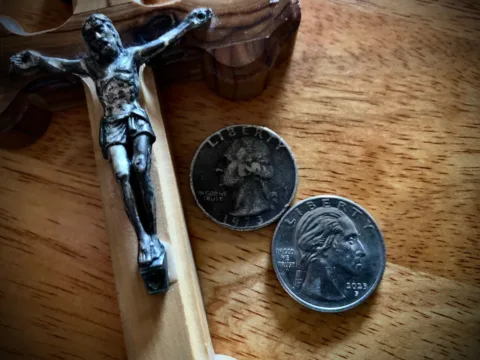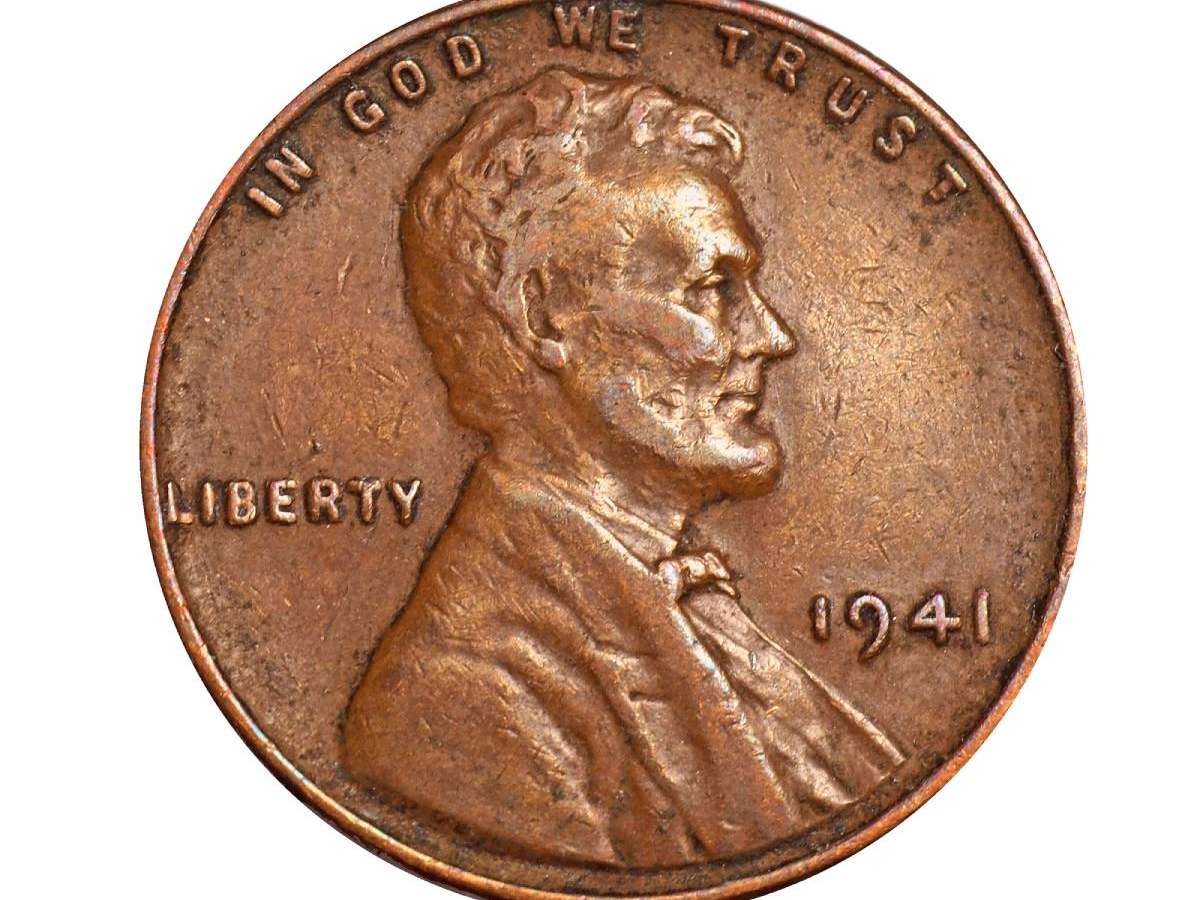Why Is Washington Facing Away?

Have you seen the new American Women Quarters? They have George Washington turning his back on the motto “IN GOD WE TRUST.”
It’s something I didn’t even notice until I recently saw a social media post pointing out the difference between the new quarters.
It says Washington’s head is turned to the right, away from “IN GOD WE TRUST” while on the older quarters his portrait faces left, looking at the national motto.
The crazy thing was I’ve seen tens of thousands of quarters in my life and had to look twice to see if this was really true about Washington’s portrait facing away from “IN GOD WE TRUST.”
Why Did Washington Turn His Back On God On The New Quarter?
Of course, something like this stirs up a lot of emotions, largely from people who think the U.S. government is trying to make a subtle (or maybe not so subtle) statement about religion. Maybe it’s a sign they’re trying to remove God from society one thing at a time.
I went down the rabbit hole with this on various online comment forums… I was curious what everyone was saying about it.
Some are saying “that’s messed up” and “very disturbing and telling” that Washington now faces away from “IN GOD WE TRUST” on the new quarters.
“Dark days are upon us!” wrote another.
“That’s how it starts.”
Others are quick to remind the upset commentors that the United States’ founding fathers did not establish America as a Christian nation. Article 11 from 1797’s Treaty of Tripoli unequivocally states “the government of the United States of America is not in any sense founded on the Christian Religion.”
Several commenters noted a famous quote by James Madison, one of the nation’s most influential founding fathers, who wrote “religion and government will both exist in greater purity, the less they are mixed together.”
So, what’s going on with the new quarters and God then? Why did the United States Mint start striking quarters in 2022 that show Washington turned away from the motto “IN GOD WE TRUST” when he looked toward the motto in the past?
Is it all part of a bigger plot to totally scrub any reference to God from the public forum? Some might say they are taking God off our money…
Hold on though!
Those who know their numismatic history will quickly realize the design seen on the new quarters with Washington “turning his back on God” is anything but new. In fact, the design on the obverse (“heads side”) of the American Women Quarters dates back to 1932!
A Quick History Of The Washington Quarter’s Design
The Washington quarter design that so many of us are familiar with from the 20th century was not the design originally intended for the coin.
That’s right… Since its inception in 1932 until the start of the state quarters in 1999, the Washington quarter carried an obverse design of George Washington by John Flanagan. And, actually, the John Flanagan design was largely based off an 18th-century bust by sculptor Jean-Antoine Houdon.
But Flanagan’s Washington design wasn’t the one that many government officials wanted to put on the quarter in 1932 to honor the first U.S. president’s 200th birthday. A parade of upper government officials and the Fine Arts Commission had instead cast their votes (literal and figurative) for a design by sculptor-engraver Laura Gardin Fraser. If her name sounds familiar, it should…
The 1932 Laura Gardin Fraser design is the very one that appeared on the quarter in 2022!
That means the “new” design of Washington turning his back on “IN GOD WE TRUST” is not a new design at all — it was first pitched and favored by many government officials back in 1932.
But let’s back things up here… If the Fraser design was supposed to be on the quarter all this time, why wasn’t it used back in the 1930s?
We can thank Andrew Mellon, who served as Secretary of the Treasury when the decisions surrounding the new Washington quarter were going on in the early 1930s. As Secretary of the Treasury, he had the final say on what design would appear on new U.S. coins — and he rejected Fraser’s motif of Washington in favor of Flanagan’s, which ended up on the quarter for many decades.
Many believe Mellon rejected the design by Fraser on the basis of her being a woman, though others say there is no proof this is why he rejected her motif of Washington.
While it was Flanagan’s design that we saw on the Washington quarter since the 1930s (it was heavily modified by William Cousins in 1999 for the 50 State Quarters and other quarter programs), many didn’t forget Fraser’s design.

In 1999, the U.S. Mint used Fraser’s 1932 Washington design for a gold commemorative coin.
Years later, when the American Women Quarters were planned for release from 2022 through 2025, program planners felt it appropriate to pair designs of influential women on the reverse (“tails side”) of the coins with a depiction of Washington created by a woman — Fraser.
And that’s why Washington turned his back on IN GOD WE TRUST on the new quarters… It was part of the original design planned for the Washington quarter way back when.
It just took a roundabout path and 90 years to get there!
Other Controversies Involving “IN GOD WE TRUST” On U.S. Coins
The stir over the new Washington quarters and “IN GOD WE TRUST” immediately brought to my mind two similar events that happened in the first decade of the 2000s.
The first of these were the famous IN GOD WE RUST 2005 Kansas state quarter errors, which made the news. The IN GOD WE RUST quarters became valuable collectibles caused by a filled die error that obliterated the first “T” of “TRUST.” Some thought it was an evil prank — maybe even a government ploy to demean God. But it’s just an error — and a valuable one at that!
Then there were the Godless dollars. Oh my, the Godless dollars… That whole incident was a real bruhaha!
The Godless dollars were unintentionally struck in 2007 and 2008 as a result of the edge lettering, containing the motto “IN GOD WE TRUST,” not being rendered on the Presidential $1 coins.
Many people thought the 2007 and 2008 Godless dollars were another move by the government to expunge God from American life.
After all, they had relegated “IN GOD WE TRUST” to the edge of the coin (along with the coin’s date, mintmark, and legend “E PLURIBUS UNUM.” Now they were (perhaps “subversively”?) removing “IN GOD WE TRUST” from the coin.
The controversy spilled into the national headlines, making the Godless dollar errors valuable coins overnight. Many were selling for $100, $200, or even more.
It spun into bad press for the U.S. Mint, which took action in 2009 to prevent any further Godless dollars from being inadvertently struck by moving the motto to the obverse of the Presidential $1 coins.
“IN GOD WE TRUST” On U.S. Coins History
All of these stories involving the supposed removal or defilement of “IN GOD WE TRUST” on U.S. coins begs the question: When did the U.S. first put “IN GOD WE TRUST” on coins anyway?
The history of “IN GOD WE TRUST” on U.S. coins goes back to the Civil War — which occurred in the first half of the 1860s. Supporters of the Union wanted to help boost morale, and the idea was that “IN GOD WE TRUST” would be an uplifting sentiment.
The motto first appeared on the nation’s 2 cent coin in 1864.
A law was passed in 1873 that permitted use of “IN GOD WE TRUST” on all new U.S. coins, and during the heart of the Cold War in 1955 a joint resolution signed by President Dwight Eisenhower required “IN GOD WE TRUST” to appear on all U.S. coins and paper money.
The following year, in 1956, President Eisenhower signed a law making “IN GOD WE TRUST” the national motto. The Series 1957 Silver Certificates were the first U.S. paper currency that carried “IN GOD WE TRUST” as part of the series of 1950s laws concerning the phrase.
Needless to say, not everyone agrees that “IN GOD WE TRUST” should appear on U.S. money. But barring a major act of Congress or other act of government lawmaking that would likely prove highly unpopular with the masses even today, “IN GOD WE TRUST” on American money isn’t going anywhere anytime soon.
READ NEXT: Find Out How Much Your Coins Are Worth
I’m the Coin Editor here at TheFunTimesGuide. My love for coins began when I was 11 years old. I primarily collect and study U.S. coins produced during the 20th century.
I’m a member of the American Numismatic Association (ANA) and the Numismatic Literary Guild (NLG) and have won multiple awards from the NLG for my work as a coin journalist. I’m also the editor at the Florida United Numismatists Club (FUN Topics magazine), and author of Images of America: The United States Mint in Philadelphia (a book that explores the colorful history of the Philadelphia Mint). I’ve contributed hundreds of articles for various coin publications including COINage, The Numismatist, Numismatic News, Coin Dealer Newsletter, Coin Values, and CoinWeek.
I’ve authored nearly 1,000 articles here at The Fun Times Guide to Coins (many of them with over 50K shares), and I welcome your coin questions in the comments below!





